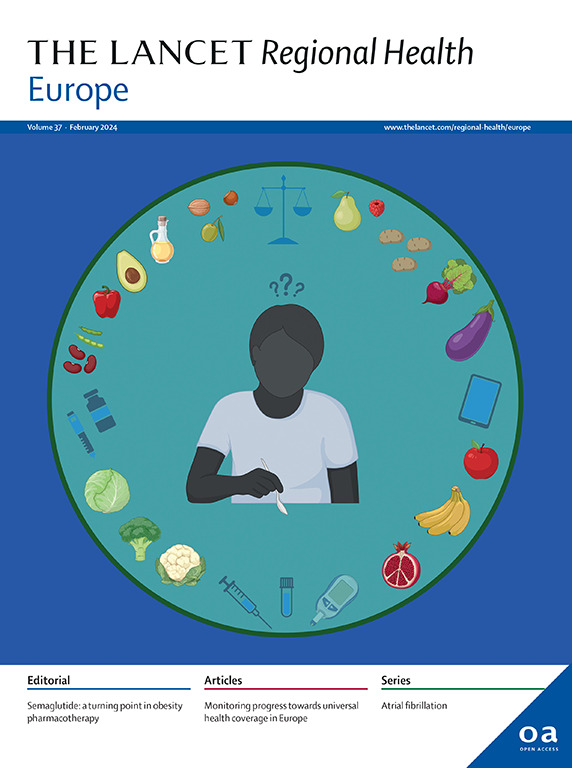Mental well-being in adolescence and eight years of follow-up for mental illness, risky behaviours, and mortality in 67,945 15–19-year-olds: a prospective cohort study
IF 13
Q1 HEALTH CARE SCIENCES & SERVICES
引用次数: 0
Abstract
Background
Adolescence is a sensitive developmental period during which complaints of poor mental well-being increase drastically. We investigated how social determinants associated with self-reported mental well-being and how self-reported mental well-being associated prospectively from adolescence to young adulthood with mental illness, risky behaviours, and mortality.
Methods
We used data on 67,945 Danish students aged 15–19, surveyed in 2014 (baseline). We employed a person-centred approach using Latent Class Analysis to define mental well-being subgroups with nine indicators of mental well-being: life satisfaction, self-esteem, irritability, low mood, stress, loneliness, self-efficacy, and confidence in parents and friends. By linkage to national health, social, and mortality registers, we obtained information on social determinants at baseline and the following outcomes during young adulthood: Mental illness, self-harm and suicide attempts, alcohol-related and substance use-related hospital contacts, emergency room contacts due to interpersonal violence, and all-cause mortality. Descriptive statistics were produced to illustrate associations between social determinants and mental well-being, and Poisson and Cox regression were used to estimate incidence rates and hazard ratios over the 8.2-year follow-up period.
Findings
We identified four distinct groups of mental well-being: Good (32%), Moderate (35%), Poor (19%), and Very Poor (14%). We observed pronounced gradients of social and familial disadvantage such as financial difficulties and parental alcohol problems across mental well-being groups, with greater disadvantage linked to poorer mental well-being. The risk of mental illness, self-harm and suicide attempts, alcohol-related and substance use-related hospital contacts, emergency room contacts due to interpersonal violence, and all-cause mortality was consistently lowest in the Good, at intermediate levels in the Moderate and Poor, and substantially higher in those with Very Poor mental well-being. For example, hazard ratios for mental illness were 1.51 (95% CI = 1.39, 1.64), 2.61 (2.41, 2.82) and 5.32 (4.92, 5.76) in the Moderate, Poor and Very Poor, respectively, corresponding to incidence rate differences of 27.2 (21.5, 32.8), 85.5 (77.4, 93.5) and 230 (214, 246) per 10,000, as compared to the Good mental well-being group. The higher risk of all outcomes remained across 8.2 years of follow-up. The external validity of findings was confirmed by repeating all analyses in independent data.
Interpretation
Our study reveals that poor adolescent mental well-being, as operationalised multidimensionally from self-reported information, predicts adverse outcomes and even mortality during young adulthood. These findings urgently call for mental health complaints in adolescents to be taken seriously and prioritised for identification and intervention.
Funding
The study was funded by the Tryg Foundation.
一项前瞻性队列研究:67,945名15 - 19岁青少年的青少年心理健康状况和8年的精神疾病、危险行为和死亡率随访
青春期是一个敏感的发育时期,在此期间,对心理健康状况不佳的抱怨急剧增加。我们调查了社会决定因素如何与自我报告的心理健康相关,以及自我报告的心理健康如何与青春期到青年期的精神疾病、危险行为和死亡率相关。方法:我们使用了2014年调查的67,945名15-19岁丹麦学生的数据(基线)。我们采用了以人为中心的方法,使用潜在类别分析来定义心理健康亚组,其中包括9个心理健康指标:生活满意度、自尊、易怒、情绪低落、压力、孤独、自我效能和对父母和朋友的信心。通过与国家卫生、社会和死亡率登记的联系,我们获得了基线社会决定因素的信息,以及青年期的以下结果:精神疾病、自残和自杀未遂、与酒精有关和药物使用有关的医院联系、因人际暴力而进行的急诊室联系,以及全因死亡率。描述性统计数据用于说明社会决定因素与心理健康之间的关联,并使用泊松和Cox回归来估计8.2年随访期间的发病率和风险比。研究结果我们确定了四个不同的心理健康群体:良好(32%),中等(35%),差(19%)和极差(14%)。我们观察到,在心理健康群体中,社会和家庭不利因素(如经济困难和父母酗酒问题)的差异很大,不利因素越大,心理健康状况越差。精神疾病、自残和自杀企图、与酒精有关和药物使用有关的医院接触、因人际暴力而进行的急诊室接触以及全因死亡率的风险在良好人群中始终最低,在中等和贫困人群中处于中等水平,而在精神健康状况极差的人群中则高得多。例如,中度、贫困和极贫困人群的精神疾病风险比分别为1.51 (95% CI = 1.39, 1.64)、2.61(2.41,2.82)和5.32(4.92,5.76),与良好心理健康人群相比,每万人的发病率差异分别为27.2(21.5,32.8)、85.5(77.4,93.5)和230(214,246)。在8.2年的随访中,所有结果的高风险仍然存在。通过在独立数据中重复所有分析,证实了研究结果的外部有效性。我们的研究表明,青少年心理健康状况不佳,从自我报告的信息多维度上进行操作,预示着成年早期的不良后果甚至死亡率。这些发现迫切要求认真对待青少年的心理健康投诉,并优先进行识别和干预。该研究由Tryg基金会资助。
本文章由计算机程序翻译,如有差异,请以英文原文为准。
求助全文
约1分钟内获得全文
求助全文
来源期刊

Lancet Regional Health-Europe
Multiple-
CiteScore
19.90
自引率
1.40%
发文量
260
审稿时长
9 weeks
期刊介绍:
The Lancet Regional Health – Europe, a gold open access journal, is part of The Lancet's global effort to promote healthcare quality and accessibility worldwide. It focuses on advancing clinical practice and health policy in the European region to enhance health outcomes. The journal publishes high-quality original research advocating changes in clinical practice and health policy. It also includes reviews, commentaries, and opinion pieces on regional health topics, such as infection and disease prevention, healthy aging, and reducing health disparities.
 求助内容:
求助内容: 应助结果提醒方式:
应助结果提醒方式:


